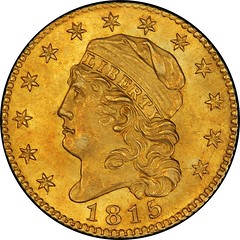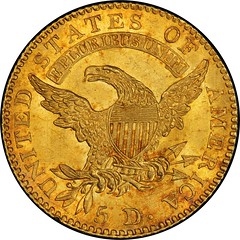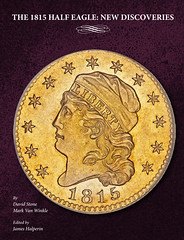
PREV ARTICLE
NEXT ARTICLE
FULL ISSUE
PREV FULL ISSUE
THE ELUSIVE 1815 HALF EAGLE
If you aspire to own a complete set of United States coins, you'll need to acquire an 1815 Half Eagle. With only 10 known genuine
examples (and just six in private hands), the coin is more rare than the famed 1804 dollars. The February 9, 2016 Stack's Bowers sale
of the Pogue collection includes the Davis-Graves specimen, considered to be the finest known example. Here's an excerpt from the
catalog description. -Editor
 
The War of 1812 was disastrous for the American economy. Following an ill-conceived embargo that punished Americans more than their enemies, incursions over the American border in 1813, and an invasion of the American capital in 1814, specie was hoarded and the economy ground to a halt. The Mint was all but shuttered for most of 1815, with the war preventing the importation of cent planchets from England and the economic issues manifesting in very few deposits of specie. Only tiny deposits of gold came into the Mint, two of which arrived in 1815 and one of which remained leftover from late 1814, so it took but one day to produce the entire year’s production of half eagles. “The entire mintage of 635 coins was struck, probably in less than an hour, on November 3, 1815,” wrote Bill Eckberg in a 2015 article on the year’s coinage, published in Coin World. Researcher R.W. Julian calculated the number of 1815 half eagles given to each depositor: “Thomas Parker received 67 of the coins, Charles F. Kalkman another 210 pieces and the Bank of Pennsylvania was sent the rest, 358 pieces.” These 635 coins represented all the gold coins struck by the United States Mint in 1815, one of the smallest annual mintages of any denomination during the Mint’s long history. While knowledge of American coins has evolved significantly over the last 150 years, the 1815 half eagle is one of only a few issues that have ever been seriously considered the rarest American coin. In April 1883, when S. Hudson and Henry Chapman offered an example of this issue to T. Harrison Garrett, they called it “the rarest coin of the U.S. regular series” and noted that “but four specimens of this date are known to exist, which cannot, we think, be said of any other date of U.S. coins.” They correctly added that the 1815 half eagle is “of greater rarity than the dollar of 1804” and surmised that “in a few years, when the collecting of gold develops, it will no doubt command a very large figure.” Their prescience is borne out by auction data compiled by P. Scott Rubin. The next authentic 1815 half eagle to sell at auction after 1883 was the example in the H.P. Smith sale of 1906, which sold for $1,050. The next year, the Stickney coin brought $2,000, and prices continued to increase thereafter. This example, once part of the Virgil Brand Collection, is almost certainly the example purchased by Brand from the Guttag Brothers in 1925. Brand owned two 1815 half eagles. One was acquired for $200 in 1899 from the relatively obscure German-born dealer M. David in a transaction that included the Eliasberg-Pogue 1822 half eagle. At the time, $200 was an inexpensive price for an 1815 half eagle. Extensive research on this issue by Saul Teichman and the team of David Stone and Mark Van Winkle has found only ten known specimens. These experts, the grading services, and all other authorities agree: there is no finer specimen than this one. The provenance of each specimen has been rendered in detail by Stone and Van Winkle in The 1815 Half Eagle: New Discoveries, which has revealed that the specimen long thought to be in the Connecticut State Library is actually an altered 1813 half eagle and confirms that the example Joseph J. Mickley said was in the Swedish Mint cabinet really does exist. Purchased in 1851 “with 19 other gold coins from other countries,” the example in the Kungliga Myntkabinettet in Stockholm is illustrated and described in The 1815 Half Eagle.
For more information on the book, see these earlier E-Sylum articles:
Wayne Homren, Editor The Numismatic Bibliomania Society is a non-profit organization promoting numismatic literature. See our web site at coinbooks.org. To submit items for publication in The E-Sylum, write to the Editor at this address: whomren@gmail.com To subscribe go to: https://my.binhost.com/lists/listinfo/esylum All Rights Reserved. NBS Home Page Contact the NBS webmaster 
|
